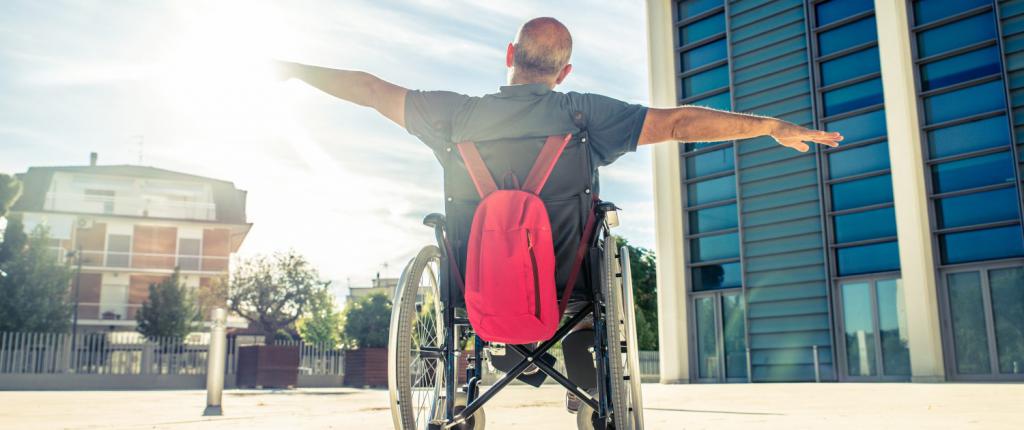In the article, we consider the norms of ramps for the disabled in public buildings.
A ramp is a sloping structure along which low-mobility groups of people can climb to the entrance in public places or residential buildings.
The presence of special gentle slopes at the entrances to the buildings provides people with disabilities with free access to any residential or public premises on a par with people who do not have any particular health. Therefore, such designs should provide all the necessary conditions for the access of disabled people without restrictions.
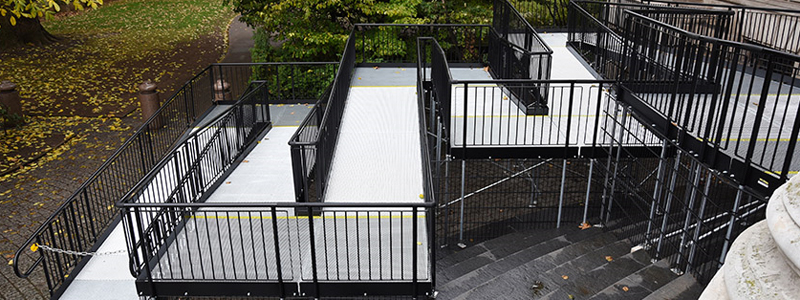
According to existing state regulations prescribed in the law, each public building should be equipped with at least one entrance equipped with a special inclined surface, called a ramp, for the direct movement of wheelchairs on it.
Recently, in the Russian Federation, these issues have been given special attention by the legislative bodies. Legislation adopted by law requires the mandatory organization of special structures and structures for the free movement of people in wheelchairs.
We will talk about the norms of ramps for disabled people in public buildings below.
Existing ramps
According to the design features of the installation, all descents can be divided into stationary and removable, which are designed for temporary use. Stationary structures can have a capital folding or fixed structure. Fixed slopes for the disabled in public buildings are installed at the entrances, lifts to the first floors and in other public places.
Folding systems are most often used in stairwells or staircases. They usually have a small width and length. In these cases, the ramp rotary sheets or frames are installed vertically against the wall, fixed with a latch and lowered to the working position only if it is necessary to move the disabled person.
Telescopic ramp
Removable models of ramps for the disabled in public buildings are used as mobile slopes for installation, if necessary, anywhere. The most common such constructive portable versions:
- telescopic ramp for the disabled with adjustable lengths;
- folding ramps, which are lightweight;
- ramp - a ramp for thresholds;
- Roll-up roll ramps that can be easily placed in the trunk of a car.
The norms of ramps for disabled people in public buildings must be respected.
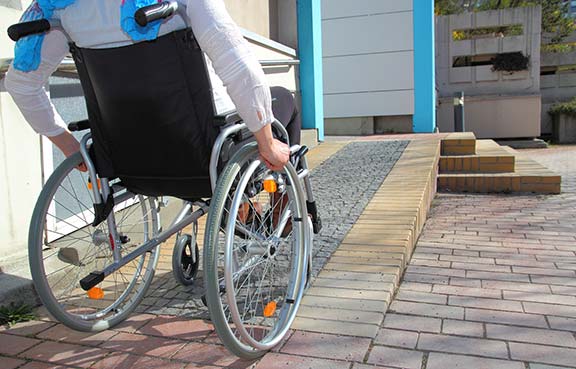
Ramp
As a variety of ramps, retractable structures installed in public transport should be noted. Such a device is activated by pressing a button, or the driver of the vehicle makes it from its place.
Designs of stationary slopes
An overhang for wheelchairs is a building structure made of concrete, metal or stone materials, which has a flat surface with a slope angle prescribed by law. At the lower and upper points of such a structure are horizontal platforms for stopping after ascent or descent. They greatly facilitate the process of using an inclined staircase.
What are the standards of ramps for the disabled according to GOST?
The requirements determine the installation of structures in cases of horizontal mismatch of the adjoining surface of more than 50 mm. With a height difference of more than 200 mm, the ramp should consist of three elements:
- upper horizontal platform;
- inclined descent to move;
- ground floor or flat, hard surface.
The size of the stopping platforms according to GOST and the width of the ramp must necessarily correspond to the dimensions of all known wheelchairs. In the case of a descent length of more than 9 meters, the construction of an intermediate turning platform is provided, from which the next marching rise begins.
What other design standards for ramps for the disabled should be taken into account?
With a difference of less than 200 mm, a horizontal platform is not installed, and the design of the ramp is a roll bridge. In some cases, with very cramped space, the design of screw structures or mechanical lifts is allowed.
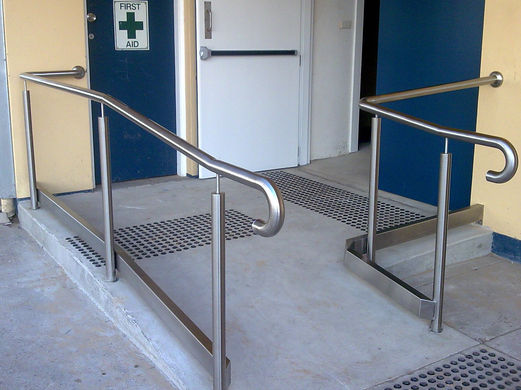
The platforms and the track from the outside should be limited by stable rails, the height of which is also normalized according to GOST. To ensure the stability of a stationary ramp, like any major building construction, a support foundation is required that can withstand a certain weight load.
Many people are interested in the standards for the implementation of metal fencing ramps for the disabled.
Modern building codes
The requirements for the design of ramp slopes for the movement of wheelchairs are determined by three current regulatory documents:
- Code of Practice 59.13330.2012.
- SNiP 35-01-2012.
- GOST R 51261-99.
The Construction Norms and Regulations set out all design requirements for the size of the ramp for the disabled for stationary installation techniques. The necessary tilt angles of the march, their maximum length, width, size of the platforms and mounting elements of an additional character in the form of safety sides, railings and other are also indicated.
The code of rules is the most expanded and current edition of SNiP. It indicates standards that are slightly different from the previous ones in terms of reducing the ramp track inclination angles, its maximum length, expanding the dimensions of the platforms and the dimensions of the passage, additional design devices to ensure the best safety and ease of use. But it is necessary to take into account that the SNiP according to technical instructions is legislatively higher than the joint venture. Therefore, if the list of technical conditions and design documentation does not stipulate the performance of work under the terms of the set of rules, then the usual standards apply.
The norms for installing a ramp for disabled people are everywhere identical, but a feature of GOST is a more extensive presentation of the installation of a railing. It indicates in which cases the installation of railings should be mandatory, and also sets out special requirements for their designs.
So, what are the standards for ramp railings for the disabled?

Regulatory Designs and Dimensions
The height of one span should be no more than 800 mm. This value is capable of providing a horizontal length of a possible descent of up to 9.0 m. The width of the ramp for wheelchairs for disabled people with one-way traffic is a size of 1500 mm, and in the case of two-way crossing - 1800 mm.
The optimal width of the ramp for the disabled according to the standards should be 2000 mm. At the edge of the ramp, bumpers with a height of 50 mm or metal tubes at a height of 100 mm are installed.
The construction of double-track ramp options is allowed only in case of individual use. In the area of public buildings, ramp descents should have a continuous single coverage. To lift the assistant accompanying the disabled person, it is allowed to have a strip of steps in the middle of the lift that have a width of up to 400 mm.
Next, we consider new standards for the slope of the ramp for the disabled.
Ramp Angle Limits
The slope of the ramp for wheelchair users with disabilities according to modern standards should not exceed 15%. This means that for one meter of horizontal surface the rise should be 15 cm.In the practice of designing, the indicator should be considered the optimal slope by 10%, and it increases only if it is impossible to make another decision. The maximum height difference in no case should exceed 18%. On existing stairways, installation of ramps is prohibited due to inconsistency of the slope of the descent to regulatory requirements.
Unfortunately, the slope standards for the ramp for the disabled are not yet met everywhere.
Site Requirements
Ramps are equipped with upper, entrance and, if necessary, intermediate horizontal platforms. According to the instructions of the law, their sizes must correspond to such indicators:
- width - not less than 1850 mm;
- depth with doors opening inward - 1400 mm, opening outward - 1500 mm;
- a place for the wheelchair to turn around - from 2200 mm.
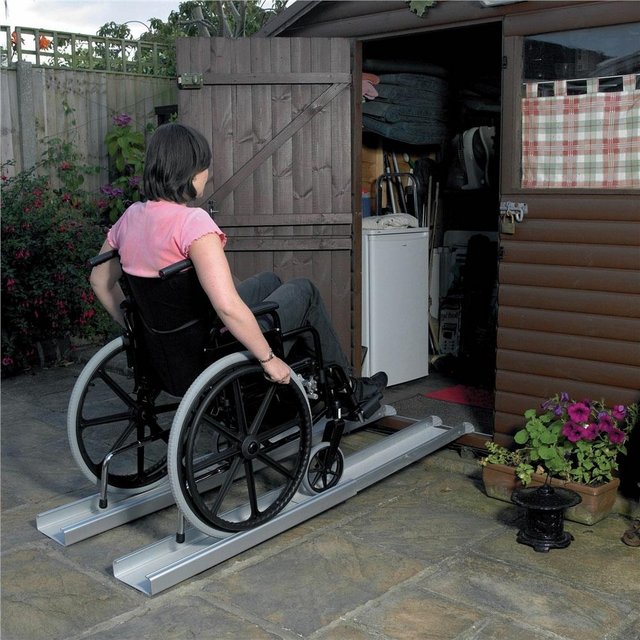
When opening the front door to the outside, the size of the site should take into account the possibility of maneuvering the wheelchair at that moment. Therefore, the depth and width can be slightly increased.
To prevent icing of structures that are located in the open air and do not have a special canopy, their surface should be covered with anti-slip materials or have a heating that works in cold weather.
We continue to consider the standards of ramps for the disabled.
The width of the intermediate platforms should coincide in size with the ramp tracks suitable for it. Recommended solutions correspond to the following sizes:
- on a direct single march - 900 x 1400 mm;
- at intermediate sites with a turn - 1500 x 1800 mm;
- with a ramp width of 900 mm and a 90-degree turn - 1400 x 1400 mm;
- with a width of 1400 mm and a change in direction of movement at a right angle - 1400 x 1500 mm.
For more convenient movement of the stroller, the configuration of the turntables can be oval on the one hand. The edges of the intermediate platform, as well as directly to the track itself, should have a frame in the form of a side or metal pipes.
The norms of ramps for disabled people in public buildings apply to fences.
Fencing elements
The determination of the fastening, height and type of construction of the ramp enclosure should be carried out in accordance with the requirements of GOST. Any side of the descent in the absence of an adjacent wall should be fenced. The design of such fences should include the presence of uneven or single paired handrails, enclosing sides and railings. Regulatory requirements for such fences:
- the height of the main handrail is 700 mm from the track surface, and the auxiliary railing is 900 mm;
- installation on all sections of the ramp and horizontal platforms;
- fastening of protections is carried out only from the end external side;
- the location of the railing should be in the form of a solid line at the same distance from the surface of the ramp;
- at the end of the last march, the handrails should protrude 300 mm;
- the cross-section of the handrails is round, with a diameter of 30-50 mm.
The building material of these structures must be protected from corrosion and have the necessary mechanical strength, which is necessary to resist side loads.
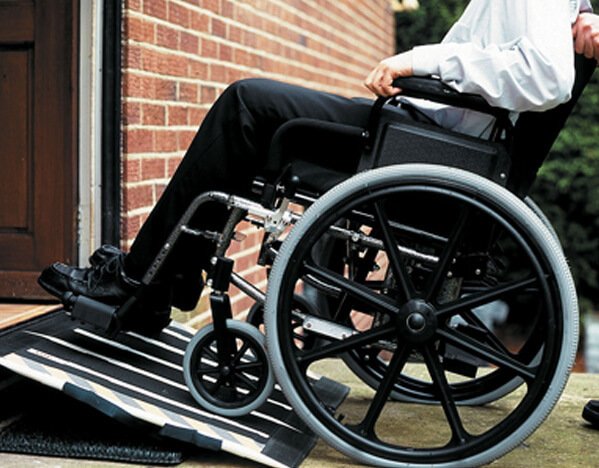
Necessary tools and materials
To make a folding double-track ramp for lifting to the first floor you will need:
- profile pipe длиной length of the ladder 25 x 50 mm;
- two metal bent channels No. 18-24 with a thickness of 3-4 mm or 4 corners 100 x 65 mm long (in accordance with the length of the flight of stairs);
- 3 door steel hinges;
- profile pipe 25 x 32 mm (2 m);
- 0.5 m steel strip 50 x 2.5 mm;
- anchor bolts for wall mounting;
- sliding or rotary latch;
- welding electrodes.
For independent production of the ramp, you need to use not a hot-rolled heavy, but a thin-walled bent channel. It is much lighter, and its strength and rigidity is enough to easily support the mass of a wheelchair and a person.In order to reduce the cost of the channel, it is allowed to replace with unequal corners, which are welded along a wide shelf and form a U-shaped structure.
Call button
If you can’t install a stationary ramp design, you can use folding versions. Then, special buttons are installed in public buildings, with the help of which a disabled person can call an employee of one or another institution to lay out a platform for lifting and help the disabled person to freely enter or leave the building.
These buttons also have certain regulatory requirements:
- the button should be located at a height of not more than 100 cm;
- from the protruding sections of the stairs or porch should be at least 40 cm;
- the button is covered with an anti-vandal protective cover;
- place it in such a way that a disabled person in a wheelchair can be seen from the building;
- operating voltage is 220 V;
- the button is marked with the “Disabled” icon.
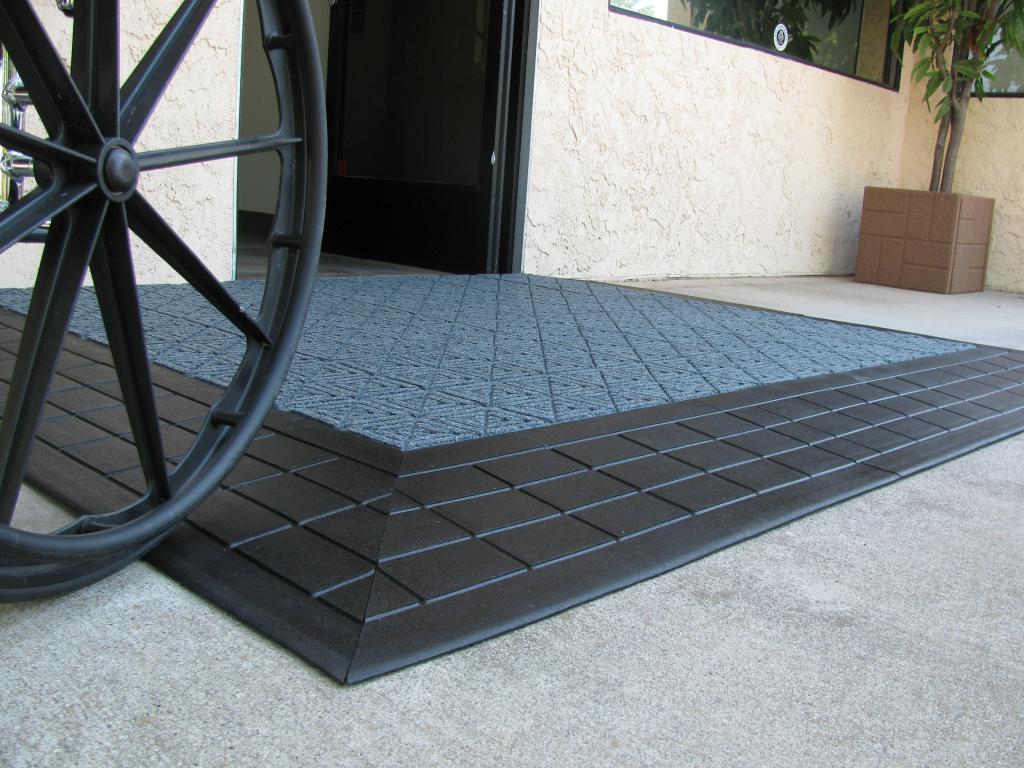
Who is responsible for compliance with all requirements when installing these structures?
The responsibility for the improper installation of the ramp, according to the law, lies with officials and legal entities. If during the construction the requirements of GOST are violated, the structures are dismantled. Officials who do not provide access for the socially difficult categories of the population to public buildings are fined up to three thousand rubles. If we are talking about a legal entity, then they pay a fine of up to 30 thousand rubles. For poor design ramp pay a fine of up to 50,000 rubles.
We examined the standards of ramps for the disabled.
